Financial Accounting Report: Disclosure Principles and Recommendations
VerifiedAdded on 2021/06/16
|21
|2452
|19
Report
AI Summary
This report analyzes the effectiveness of financial information disclosure in the annual reports of Commonwealth Bank of Australia (CBA) and National Australia Bank (NAB), focusing on the principles proposed by the International Accounting Standards Board (IASB). The report, written from an investor's perspective, evaluates the companies' adherence to disclosure standards, highlighting areas where information is lacking in terms of comparability, transparency, and format. It examines the seven key principles of effective financial information communication, including clarity, comparability, entity-specificity, organization, appropriate format, linkage, and avoidance of duplication. The report identifies deficiencies in the annual reports, such as insufficient segmental information, inconsistent segment definitions, and a lack of appropriate use of charts and graphs, leading to recommendations for improvement. The recommendations emphasize the importance of entity-specific data, appropriate formatting including the use of charts and graphs, improved navigation through linked information, and enhanced comparability. The report concludes by urging banking institutions to adopt the IASB's disclosure principles to improve the understanding of financial information and enhance the effectiveness of communication to investors.
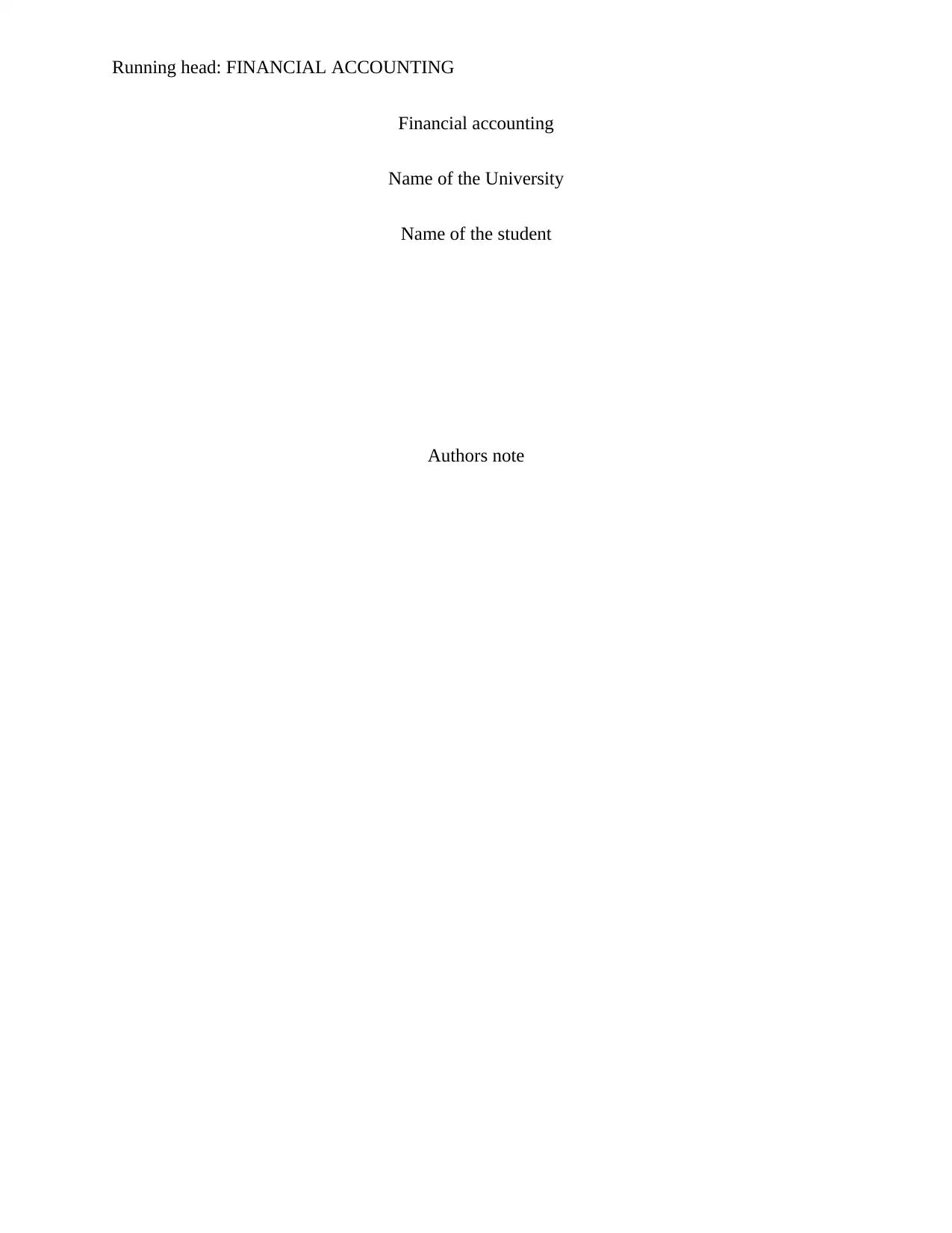
Running head: FINANCIAL ACCOUNTING
Financial accounting
Name of the University
Name of the student
Authors note
Financial accounting
Name of the University
Name of the student
Authors note
Paraphrase This Document
Need a fresh take? Get an instant paraphrase of this document with our AI Paraphraser

1
FINANCIAL ACCOUNTING
Table of Contents
Answer to Question 1:.....................................................................................................................2
Answer to Question 2:.....................................................................................................................7
Answer to Question 3:...................................................................................................................10
Answer to Question 4:...................................................................................................................14
Answer to Question 5:...................................................................................................................15
Reference list:................................................................................................................................17
FINANCIAL ACCOUNTING
Table of Contents
Answer to Question 1:.....................................................................................................................2
Answer to Question 2:.....................................................................................................................7
Answer to Question 3:...................................................................................................................10
Answer to Question 4:...................................................................................................................14
Answer to Question 5:...................................................................................................................15
Reference list:................................................................................................................................17
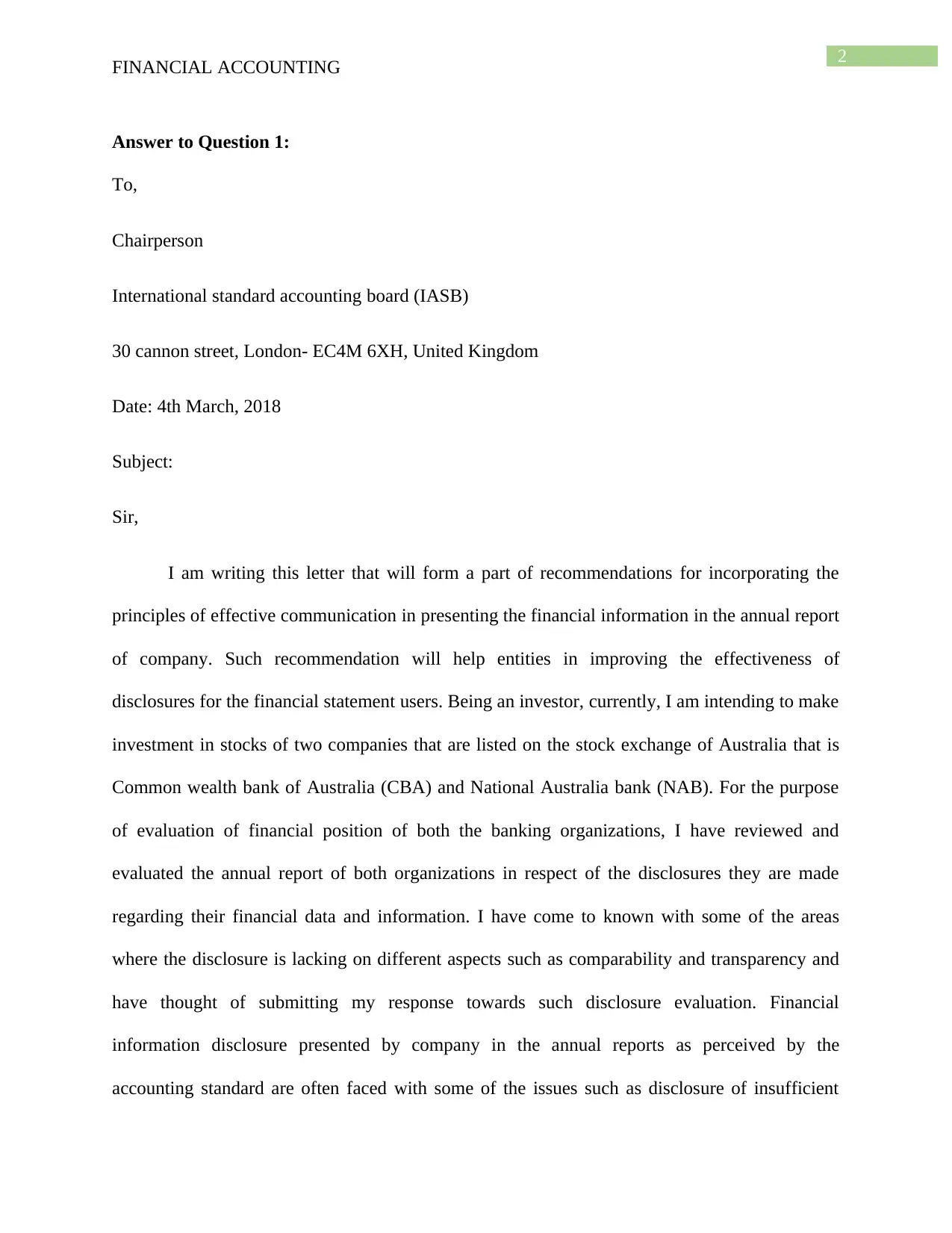
2
FINANCIAL ACCOUNTING
Answer to Question 1:
To,
Chairperson
International standard accounting board (IASB)
30 cannon street, London- EC4M 6XH, United Kingdom
Date: 4th March, 2018
Subject:
Sir,
I am writing this letter that will form a part of recommendations for incorporating the
principles of effective communication in presenting the financial information in the annual report
of company. Such recommendation will help entities in improving the effectiveness of
disclosures for the financial statement users. Being an investor, currently, I am intending to make
investment in stocks of two companies that are listed on the stock exchange of Australia that is
Common wealth bank of Australia (CBA) and National Australia bank (NAB). For the purpose
of evaluation of financial position of both the banking organizations, I have reviewed and
evaluated the annual report of both organizations in respect of the disclosures they are made
regarding their financial data and information. I have come to known with some of the areas
where the disclosure is lacking on different aspects such as comparability and transparency and
have thought of submitting my response towards such disclosure evaluation. Financial
information disclosure presented by company in the annual reports as perceived by the
accounting standard are often faced with some of the issues such as disclosure of insufficient
FINANCIAL ACCOUNTING
Answer to Question 1:
To,
Chairperson
International standard accounting board (IASB)
30 cannon street, London- EC4M 6XH, United Kingdom
Date: 4th March, 2018
Subject:
Sir,
I am writing this letter that will form a part of recommendations for incorporating the
principles of effective communication in presenting the financial information in the annual report
of company. Such recommendation will help entities in improving the effectiveness of
disclosures for the financial statement users. Being an investor, currently, I am intending to make
investment in stocks of two companies that are listed on the stock exchange of Australia that is
Common wealth bank of Australia (CBA) and National Australia bank (NAB). For the purpose
of evaluation of financial position of both the banking organizations, I have reviewed and
evaluated the annual report of both organizations in respect of the disclosures they are made
regarding their financial data and information. I have come to known with some of the areas
where the disclosure is lacking on different aspects such as comparability and transparency and
have thought of submitting my response towards such disclosure evaluation. Financial
information disclosure presented by company in the annual reports as perceived by the
accounting standard are often faced with some of the issues such as disclosure of insufficient
⊘ This is a preview!⊘
Do you want full access?
Subscribe today to unlock all pages.

Trusted by 1+ million students worldwide
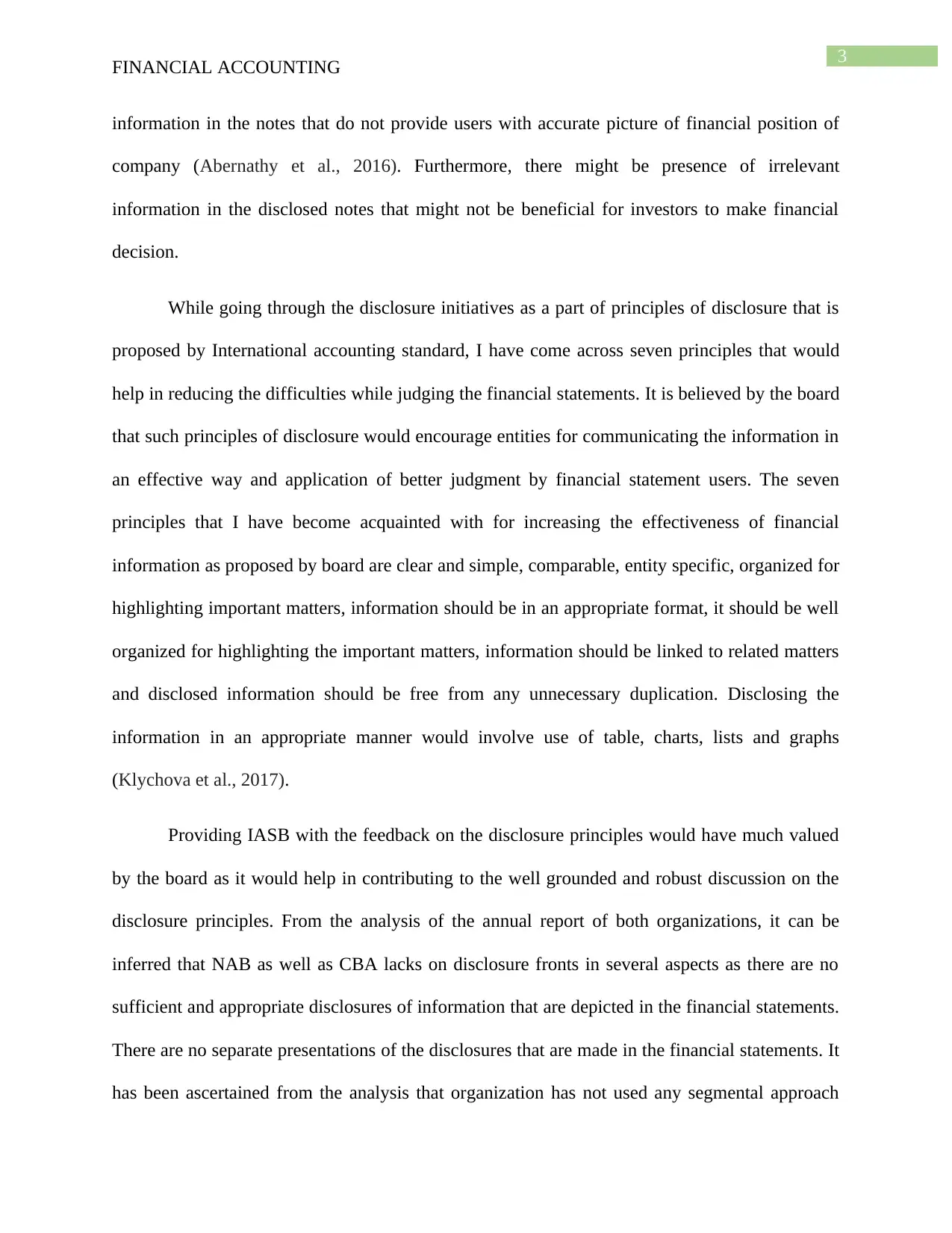
3
FINANCIAL ACCOUNTING
information in the notes that do not provide users with accurate picture of financial position of
company (Abernathy et al., 2016). Furthermore, there might be presence of irrelevant
information in the disclosed notes that might not be beneficial for investors to make financial
decision.
While going through the disclosure initiatives as a part of principles of disclosure that is
proposed by International accounting standard, I have come across seven principles that would
help in reducing the difficulties while judging the financial statements. It is believed by the board
that such principles of disclosure would encourage entities for communicating the information in
an effective way and application of better judgment by financial statement users. The seven
principles that I have become acquainted with for increasing the effectiveness of financial
information as proposed by board are clear and simple, comparable, entity specific, organized for
highlighting important matters, information should be in an appropriate format, it should be well
organized for highlighting the important matters, information should be linked to related matters
and disclosed information should be free from any unnecessary duplication. Disclosing the
information in an appropriate manner would involve use of table, charts, lists and graphs
(Klychova et al., 2017).
Providing IASB with the feedback on the disclosure principles would have much valued
by the board as it would help in contributing to the well grounded and robust discussion on the
disclosure principles. From the analysis of the annual report of both organizations, it can be
inferred that NAB as well as CBA lacks on disclosure fronts in several aspects as there are no
sufficient and appropriate disclosures of information that are depicted in the financial statements.
There are no separate presentations of the disclosures that are made in the financial statements. It
has been ascertained from the analysis that organization has not used any segmental approach
FINANCIAL ACCOUNTING
information in the notes that do not provide users with accurate picture of financial position of
company (Abernathy et al., 2016). Furthermore, there might be presence of irrelevant
information in the disclosed notes that might not be beneficial for investors to make financial
decision.
While going through the disclosure initiatives as a part of principles of disclosure that is
proposed by International accounting standard, I have come across seven principles that would
help in reducing the difficulties while judging the financial statements. It is believed by the board
that such principles of disclosure would encourage entities for communicating the information in
an effective way and application of better judgment by financial statement users. The seven
principles that I have become acquainted with for increasing the effectiveness of financial
information as proposed by board are clear and simple, comparable, entity specific, organized for
highlighting important matters, information should be in an appropriate format, it should be well
organized for highlighting the important matters, information should be linked to related matters
and disclosed information should be free from any unnecessary duplication. Disclosing the
information in an appropriate manner would involve use of table, charts, lists and graphs
(Klychova et al., 2017).
Providing IASB with the feedback on the disclosure principles would have much valued
by the board as it would help in contributing to the well grounded and robust discussion on the
disclosure principles. From the analysis of the annual report of both organizations, it can be
inferred that NAB as well as CBA lacks on disclosure fronts in several aspects as there are no
sufficient and appropriate disclosures of information that are depicted in the financial statements.
There are no separate presentations of the disclosures that are made in the financial statements. It
has been ascertained from the analysis that organization has not used any segmental approach
Paraphrase This Document
Need a fresh take? Get an instant paraphrase of this document with our AI Paraphraser
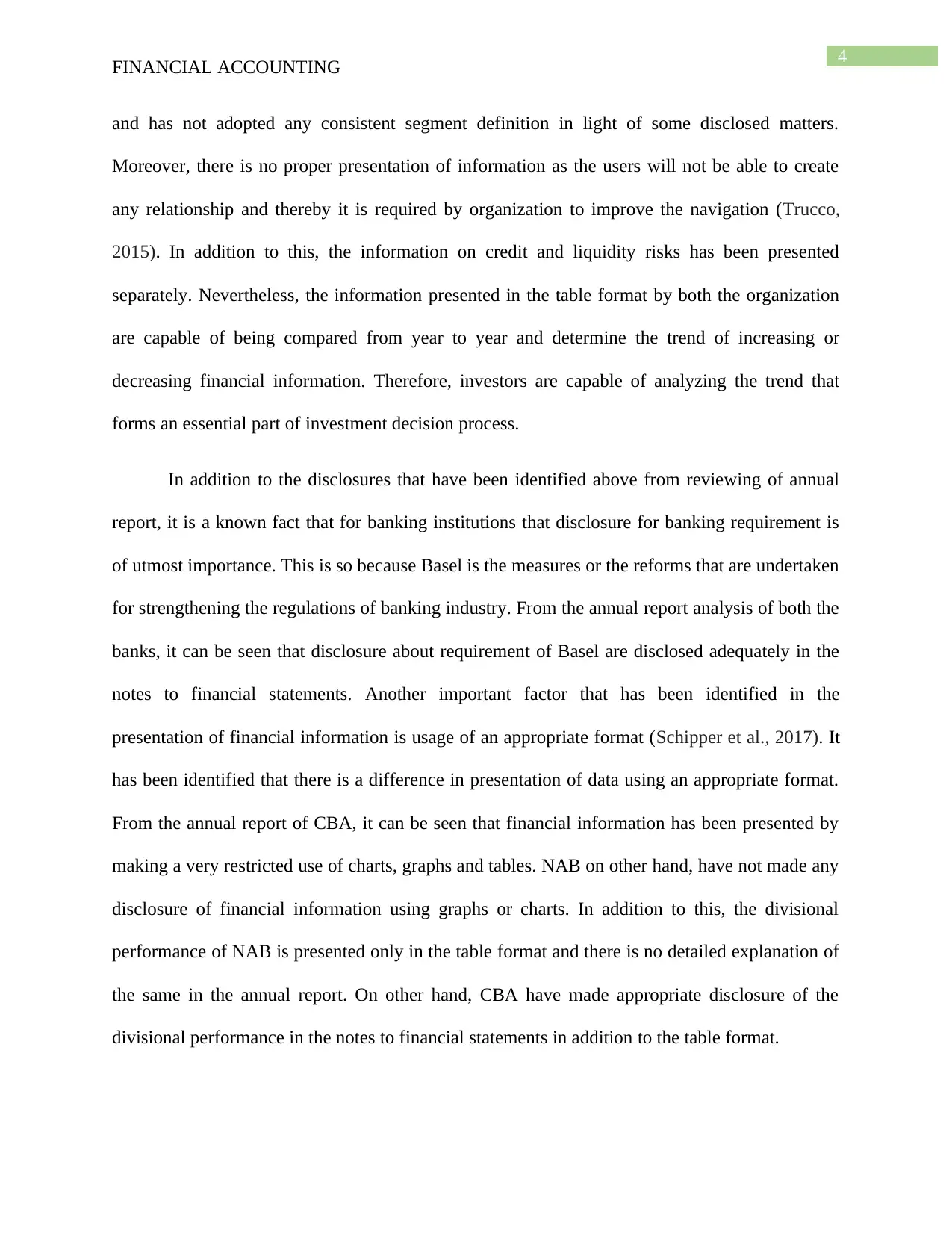
4
FINANCIAL ACCOUNTING
and has not adopted any consistent segment definition in light of some disclosed matters.
Moreover, there is no proper presentation of information as the users will not be able to create
any relationship and thereby it is required by organization to improve the navigation (Trucco,
2015). In addition to this, the information on credit and liquidity risks has been presented
separately. Nevertheless, the information presented in the table format by both the organization
are capable of being compared from year to year and determine the trend of increasing or
decreasing financial information. Therefore, investors are capable of analyzing the trend that
forms an essential part of investment decision process.
In addition to the disclosures that have been identified above from reviewing of annual
report, it is a known fact that for banking institutions that disclosure for banking requirement is
of utmost importance. This is so because Basel is the measures or the reforms that are undertaken
for strengthening the regulations of banking industry. From the annual report analysis of both the
banks, it can be seen that disclosure about requirement of Basel are disclosed adequately in the
notes to financial statements. Another important factor that has been identified in the
presentation of financial information is usage of an appropriate format (Schipper et al., 2017). It
has been identified that there is a difference in presentation of data using an appropriate format.
From the annual report of CBA, it can be seen that financial information has been presented by
making a very restricted use of charts, graphs and tables. NAB on other hand, have not made any
disclosure of financial information using graphs or charts. In addition to this, the divisional
performance of NAB is presented only in the table format and there is no detailed explanation of
the same in the annual report. On other hand, CBA have made appropriate disclosure of the
divisional performance in the notes to financial statements in addition to the table format.
FINANCIAL ACCOUNTING
and has not adopted any consistent segment definition in light of some disclosed matters.
Moreover, there is no proper presentation of information as the users will not be able to create
any relationship and thereby it is required by organization to improve the navigation (Trucco,
2015). In addition to this, the information on credit and liquidity risks has been presented
separately. Nevertheless, the information presented in the table format by both the organization
are capable of being compared from year to year and determine the trend of increasing or
decreasing financial information. Therefore, investors are capable of analyzing the trend that
forms an essential part of investment decision process.
In addition to the disclosures that have been identified above from reviewing of annual
report, it is a known fact that for banking institutions that disclosure for banking requirement is
of utmost importance. This is so because Basel is the measures or the reforms that are undertaken
for strengthening the regulations of banking industry. From the annual report analysis of both the
banks, it can be seen that disclosure about requirement of Basel are disclosed adequately in the
notes to financial statements. Another important factor that has been identified in the
presentation of financial information is usage of an appropriate format (Schipper et al., 2017). It
has been identified that there is a difference in presentation of data using an appropriate format.
From the annual report of CBA, it can be seen that financial information has been presented by
making a very restricted use of charts, graphs and tables. NAB on other hand, have not made any
disclosure of financial information using graphs or charts. In addition to this, the divisional
performance of NAB is presented only in the table format and there is no detailed explanation of
the same in the annual report. On other hand, CBA have made appropriate disclosure of the
divisional performance in the notes to financial statements in addition to the table format.
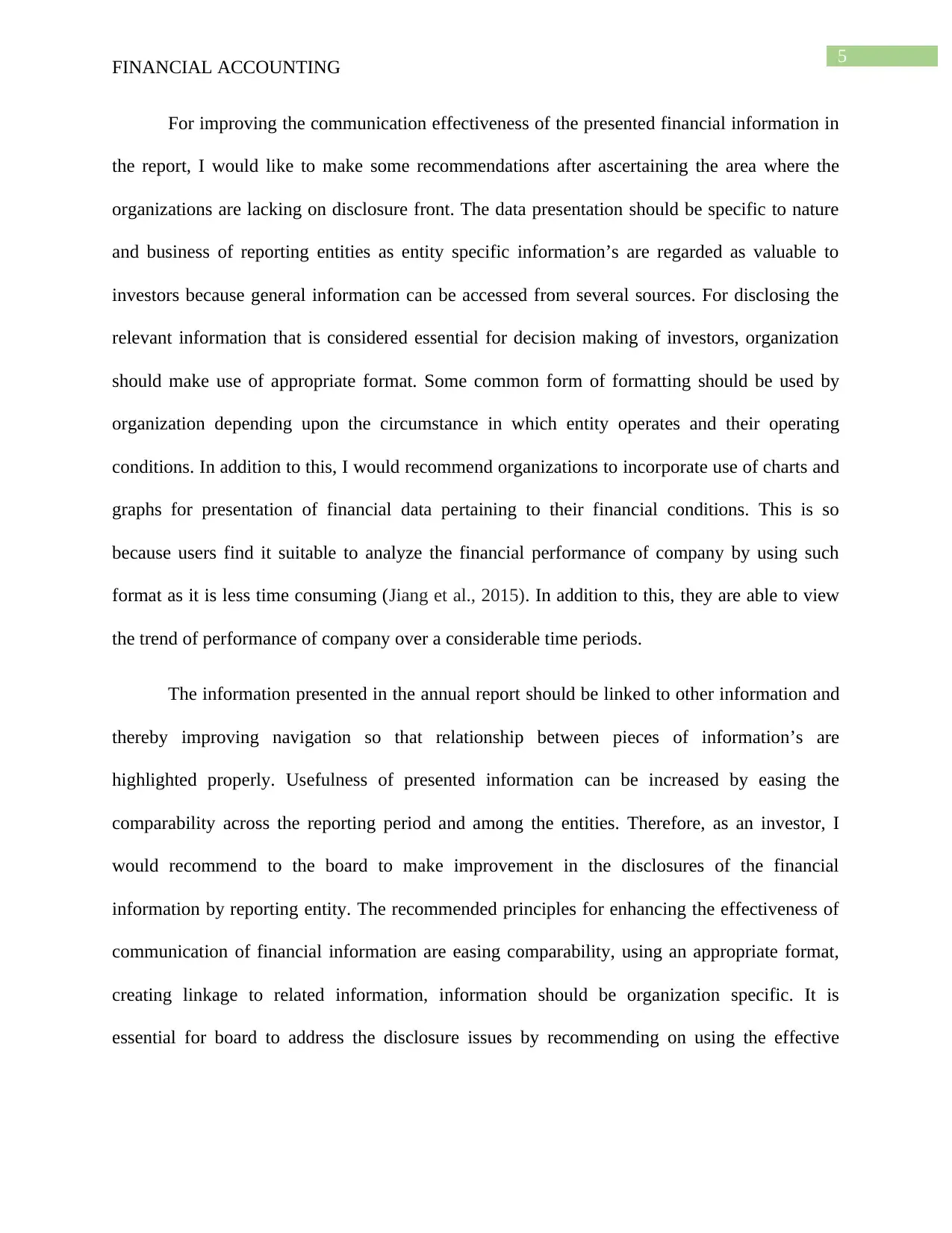
5
FINANCIAL ACCOUNTING
For improving the communication effectiveness of the presented financial information in
the report, I would like to make some recommendations after ascertaining the area where the
organizations are lacking on disclosure front. The data presentation should be specific to nature
and business of reporting entities as entity specific information’s are regarded as valuable to
investors because general information can be accessed from several sources. For disclosing the
relevant information that is considered essential for decision making of investors, organization
should make use of appropriate format. Some common form of formatting should be used by
organization depending upon the circumstance in which entity operates and their operating
conditions. In addition to this, I would recommend organizations to incorporate use of charts and
graphs for presentation of financial data pertaining to their financial conditions. This is so
because users find it suitable to analyze the financial performance of company by using such
format as it is less time consuming (Jiang et al., 2015). In addition to this, they are able to view
the trend of performance of company over a considerable time periods.
The information presented in the annual report should be linked to other information and
thereby improving navigation so that relationship between pieces of information’s are
highlighted properly. Usefulness of presented information can be increased by easing the
comparability across the reporting period and among the entities. Therefore, as an investor, I
would recommend to the board to make improvement in the disclosures of the financial
information by reporting entity. The recommended principles for enhancing the effectiveness of
communication of financial information are easing comparability, using an appropriate format,
creating linkage to related information, information should be organization specific. It is
essential for board to address the disclosure issues by recommending on using the effective
FINANCIAL ACCOUNTING
For improving the communication effectiveness of the presented financial information in
the report, I would like to make some recommendations after ascertaining the area where the
organizations are lacking on disclosure front. The data presentation should be specific to nature
and business of reporting entities as entity specific information’s are regarded as valuable to
investors because general information can be accessed from several sources. For disclosing the
relevant information that is considered essential for decision making of investors, organization
should make use of appropriate format. Some common form of formatting should be used by
organization depending upon the circumstance in which entity operates and their operating
conditions. In addition to this, I would recommend organizations to incorporate use of charts and
graphs for presentation of financial data pertaining to their financial conditions. This is so
because users find it suitable to analyze the financial performance of company by using such
format as it is less time consuming (Jiang et al., 2015). In addition to this, they are able to view
the trend of performance of company over a considerable time periods.
The information presented in the annual report should be linked to other information and
thereby improving navigation so that relationship between pieces of information’s are
highlighted properly. Usefulness of presented information can be increased by easing the
comparability across the reporting period and among the entities. Therefore, as an investor, I
would recommend to the board to make improvement in the disclosures of the financial
information by reporting entity. The recommended principles for enhancing the effectiveness of
communication of financial information are easing comparability, using an appropriate format,
creating linkage to related information, information should be organization specific. It is
essential for board to address the disclosure issues by recommending on using the effective
⊘ This is a preview!⊘
Do you want full access?
Subscribe today to unlock all pages.

Trusted by 1+ million students worldwide
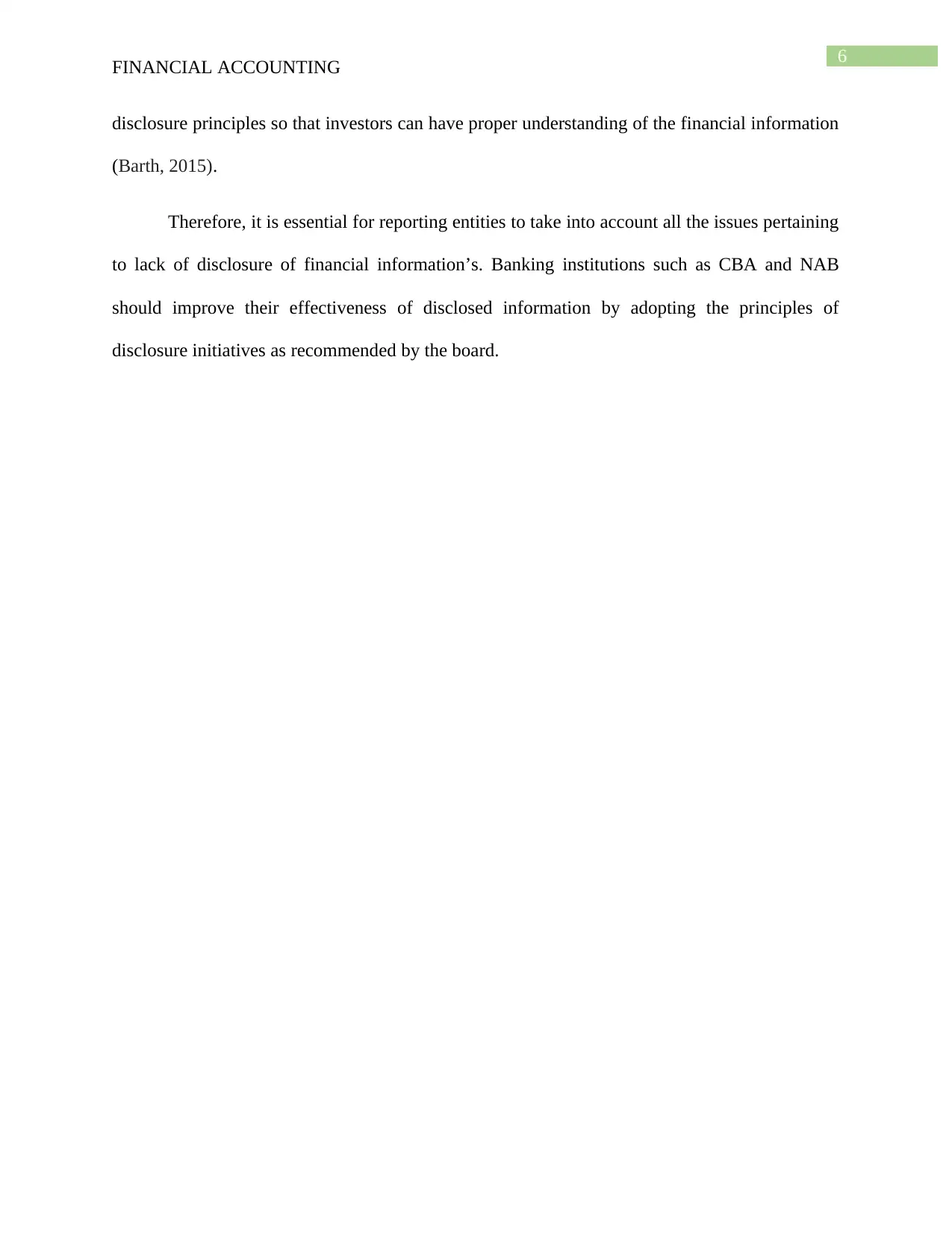
6
FINANCIAL ACCOUNTING
disclosure principles so that investors can have proper understanding of the financial information
(Barth, 2015).
Therefore, it is essential for reporting entities to take into account all the issues pertaining
to lack of disclosure of financial information’s. Banking institutions such as CBA and NAB
should improve their effectiveness of disclosed information by adopting the principles of
disclosure initiatives as recommended by the board.
FINANCIAL ACCOUNTING
disclosure principles so that investors can have proper understanding of the financial information
(Barth, 2015).
Therefore, it is essential for reporting entities to take into account all the issues pertaining
to lack of disclosure of financial information’s. Banking institutions such as CBA and NAB
should improve their effectiveness of disclosed information by adopting the principles of
disclosure initiatives as recommended by the board.
Paraphrase This Document
Need a fresh take? Get an instant paraphrase of this document with our AI Paraphraser

7
FINANCIAL ACCOUNTING
Answer to Question 2:
FINANCIAL ACCOUNTING
Answer to Question 2:
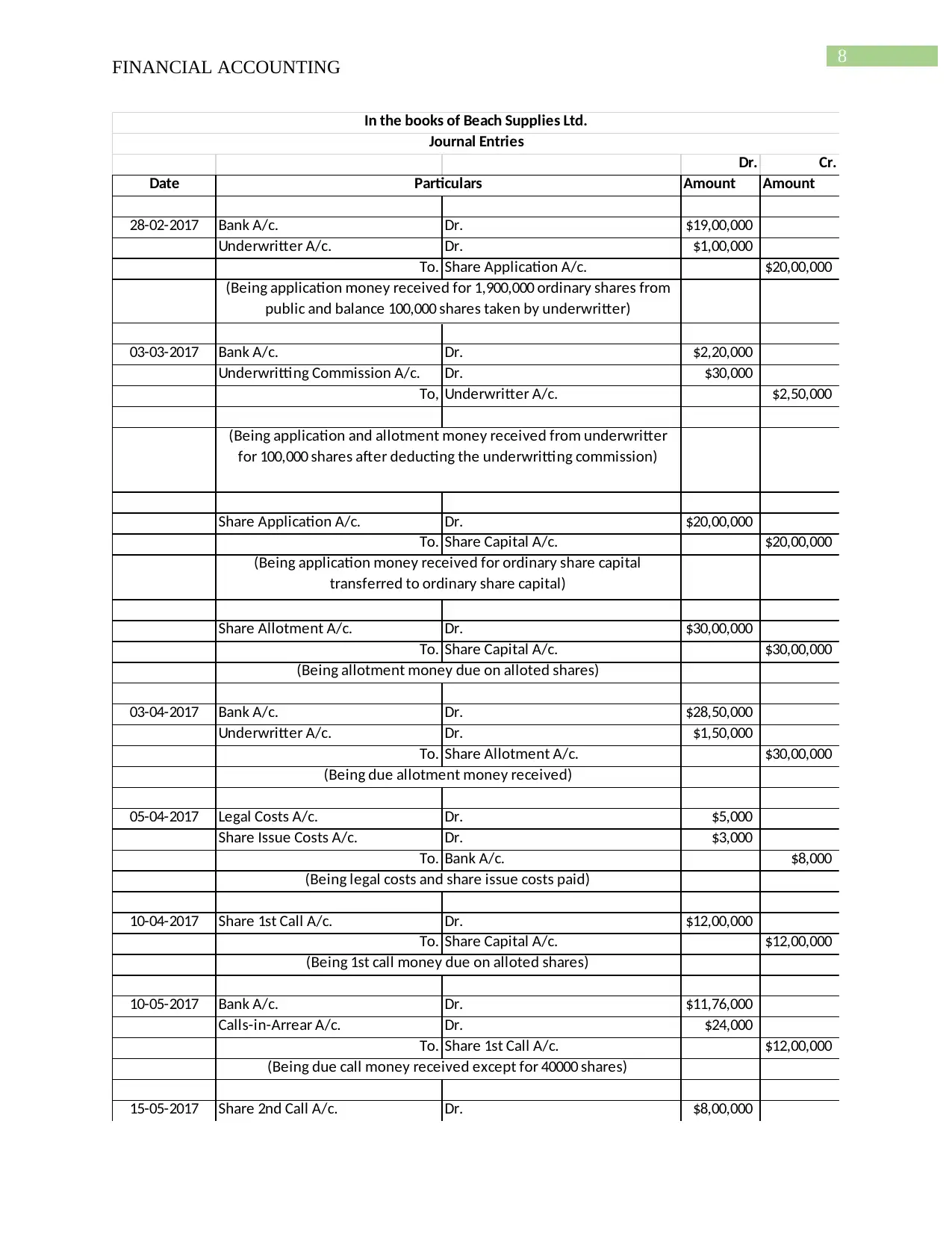
8
FINANCIAL ACCOUNTING
Dr. Cr.
Date Amount Amount
28-02-2017 Bank A/c. Dr. $19,00,000
Underwritter A/c. Dr. $1,00,000
To. Share Application A/c. $20,00,000
03-03-2017 Bank A/c. Dr. $2,20,000
Underwritting Commission A/c. Dr. $30,000
To, Underwritter A/c. $2,50,000
Share Application A/c. Dr. $20,00,000
To. Share Capital A/c. $20,00,000
Share Allotment A/c. Dr. $30,00,000
To. Share Capital A/c. $30,00,000
03-04-2017 Bank A/c. Dr. $28,50,000
Underwritter A/c. Dr. $1,50,000
To. Share Allotment A/c. $30,00,000
05-04-2017 Legal Costs A/c. Dr. $5,000
Share Issue Costs A/c. Dr. $3,000
To. Bank A/c. $8,000
10-04-2017 Share 1st Call A/c. Dr. $12,00,000
To. Share Capital A/c. $12,00,000
10-05-2017 Bank A/c. Dr. $11,76,000
Calls-in-Arrear A/c. Dr. $24,000
To. Share 1st Call A/c. $12,00,000
15-05-2017 Share 2nd Call A/c. Dr. $8,00,000
Particulars
(Being application money received for 1,900,000 ordinary shares from
public and balance 100,000 shares taken by underwritter)
(Being application and allotment money received from underwritter
for 100,000 shares after deducting the underwritting commission)
(Being application money received for ordinary share capital
transferred to ordinary share capital)
(Being allotment money due on alloted shares)
(Being due allotment money received)
(Being 1st call money due on alloted shares)
(Being due call money received except for 40000 shares)
(Being legal costs and share issue costs paid)
In the books of Beach Supplies Ltd.
Journal Entries
FINANCIAL ACCOUNTING
Dr. Cr.
Date Amount Amount
28-02-2017 Bank A/c. Dr. $19,00,000
Underwritter A/c. Dr. $1,00,000
To. Share Application A/c. $20,00,000
03-03-2017 Bank A/c. Dr. $2,20,000
Underwritting Commission A/c. Dr. $30,000
To, Underwritter A/c. $2,50,000
Share Application A/c. Dr. $20,00,000
To. Share Capital A/c. $20,00,000
Share Allotment A/c. Dr. $30,00,000
To. Share Capital A/c. $30,00,000
03-04-2017 Bank A/c. Dr. $28,50,000
Underwritter A/c. Dr. $1,50,000
To. Share Allotment A/c. $30,00,000
05-04-2017 Legal Costs A/c. Dr. $5,000
Share Issue Costs A/c. Dr. $3,000
To. Bank A/c. $8,000
10-04-2017 Share 1st Call A/c. Dr. $12,00,000
To. Share Capital A/c. $12,00,000
10-05-2017 Bank A/c. Dr. $11,76,000
Calls-in-Arrear A/c. Dr. $24,000
To. Share 1st Call A/c. $12,00,000
15-05-2017 Share 2nd Call A/c. Dr. $8,00,000
Particulars
(Being application money received for 1,900,000 ordinary shares from
public and balance 100,000 shares taken by underwritter)
(Being application and allotment money received from underwritter
for 100,000 shares after deducting the underwritting commission)
(Being application money received for ordinary share capital
transferred to ordinary share capital)
(Being allotment money due on alloted shares)
(Being due allotment money received)
(Being 1st call money due on alloted shares)
(Being due call money received except for 40000 shares)
(Being legal costs and share issue costs paid)
In the books of Beach Supplies Ltd.
Journal Entries
⊘ This is a preview!⊘
Do you want full access?
Subscribe today to unlock all pages.

Trusted by 1+ million students worldwide
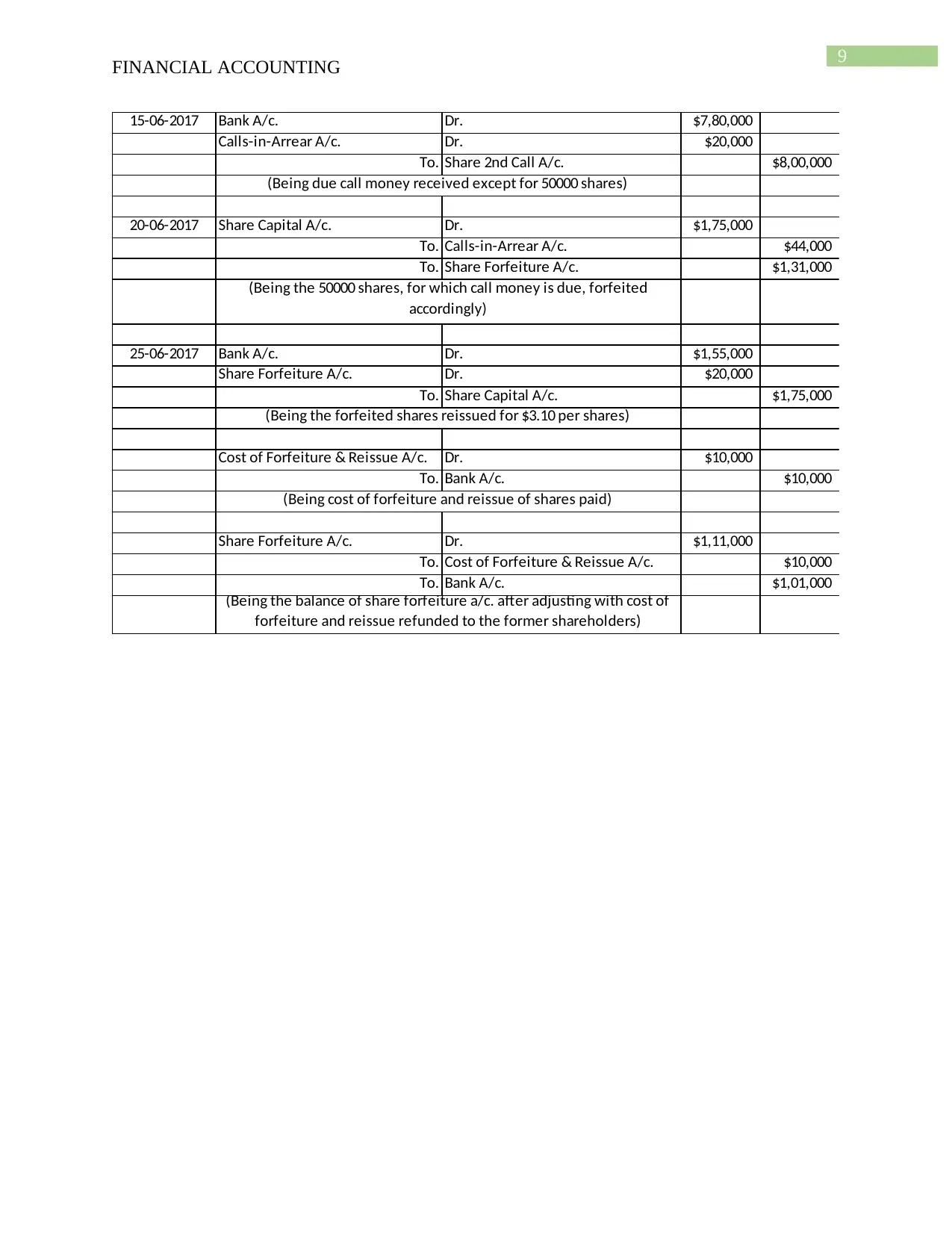
9
FINANCIAL ACCOUNTING
15-06-2017 Bank A/c. Dr. $7,80,000
Calls-in-Arrear A/c. Dr. $20,000
To. Share 2nd Call A/c. $8,00,000
20-06-2017 Share Capital A/c. Dr. $1,75,000
To. Calls-in-Arrear A/c. $44,000
To. Share Forfeiture A/c. $1,31,000
25-06-2017 Bank A/c. Dr. $1,55,000
Share Forfeiture A/c. Dr. $20,000
To. Share Capital A/c. $1,75,000
Cost of Forfeiture & Reissue A/c. Dr. $10,000
To. Bank A/c. $10,000
Share Forfeiture A/c. Dr. $1,11,000
To. Cost of Forfeiture & Reissue A/c. $10,000
To. Bank A/c. $1,01,000
(Being the balance of share forfeiture a/c. after adjusting with cost of
forfeiture and reissue refunded to the former shareholders)
(Being the 50000 shares, for which call money is due, forfeited
accordingly)
(Being the forfeited shares reissued for $3.10 per shares)
(Being cost of forfeiture and reissue of shares paid)
(Being due call money received except for 50000 shares)
FINANCIAL ACCOUNTING
15-06-2017 Bank A/c. Dr. $7,80,000
Calls-in-Arrear A/c. Dr. $20,000
To. Share 2nd Call A/c. $8,00,000
20-06-2017 Share Capital A/c. Dr. $1,75,000
To. Calls-in-Arrear A/c. $44,000
To. Share Forfeiture A/c. $1,31,000
25-06-2017 Bank A/c. Dr. $1,55,000
Share Forfeiture A/c. Dr. $20,000
To. Share Capital A/c. $1,75,000
Cost of Forfeiture & Reissue A/c. Dr. $10,000
To. Bank A/c. $10,000
Share Forfeiture A/c. Dr. $1,11,000
To. Cost of Forfeiture & Reissue A/c. $10,000
To. Bank A/c. $1,01,000
(Being the balance of share forfeiture a/c. after adjusting with cost of
forfeiture and reissue refunded to the former shareholders)
(Being the 50000 shares, for which call money is due, forfeited
accordingly)
(Being the forfeited shares reissued for $3.10 per shares)
(Being cost of forfeiture and reissue of shares paid)
(Being due call money received except for 50000 shares)
Paraphrase This Document
Need a fresh take? Get an instant paraphrase of this document with our AI Paraphraser
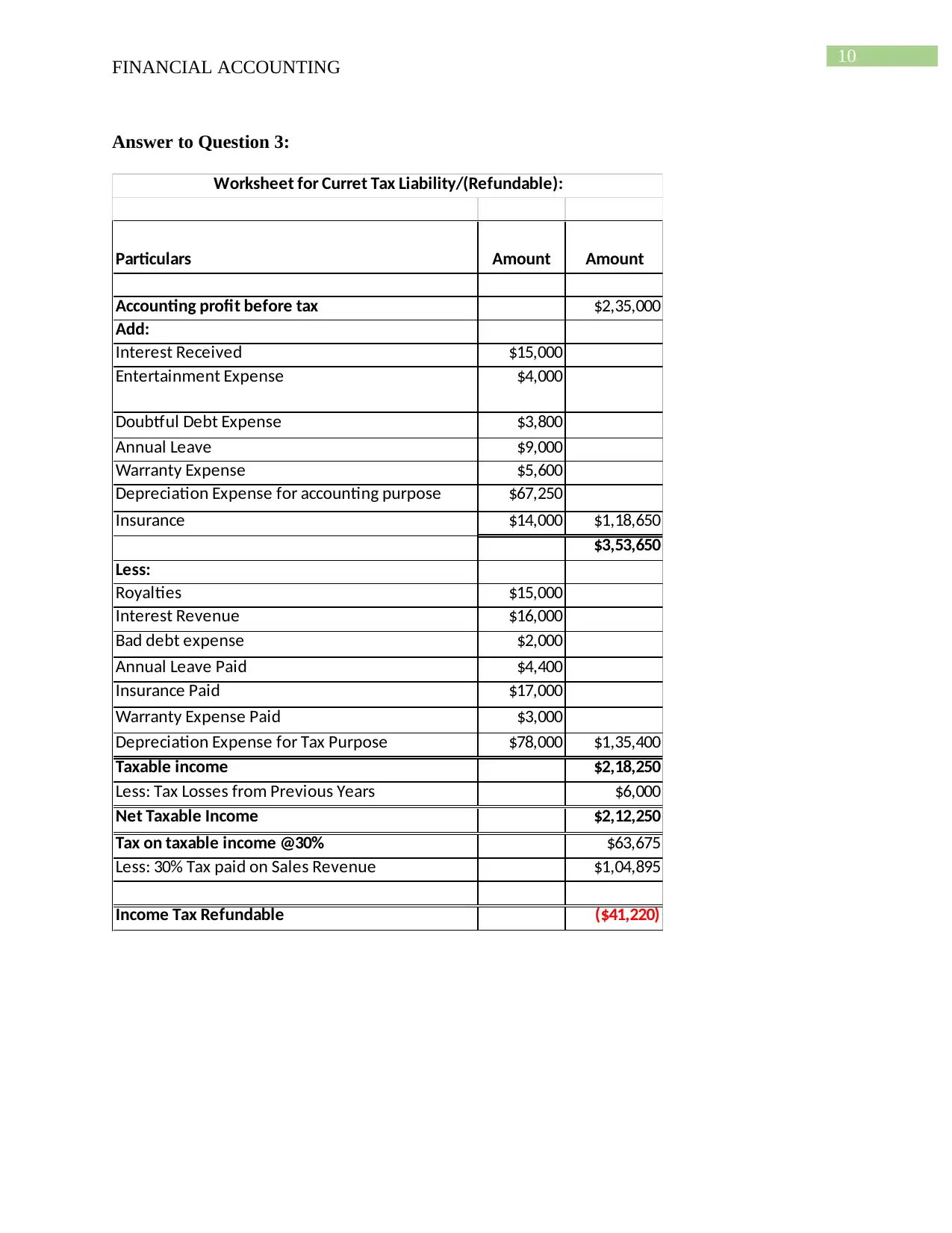
10
FINANCIAL ACCOUNTING
Answer to Question 3:
Particulars Amount Amount
Accounting profit before tax $2,35,000
Add:
Interest Received $15,000
Entertainment Expense $4,000
Doubtful Debt Expense $3,800
Annual Leave $9,000
Warranty Expense $5,600
Depreciation Expense for accounting purpose $67,250
Insurance $14,000 $1,18,650
$3,53,650
Less:
Royalties $15,000
Interest Revenue $16,000
Bad debt expense $2,000
Annual Leave Paid $4,400
Insurance Paid $17,000
Warranty Expense Paid $3,000
Depreciation Expense for Tax Purpose $78,000 $1,35,400
Taxable income $2,18,250
Less: Tax Losses from Previous Years $6,000
Net Taxable Income $2,12,250
Tax on taxable income @30% $63,675
Less: 30% Tax paid on Sales Revenue $1,04,895
Income Tax Refundable ($41,220)
Worksheet for Curret Tax Liability/(Refundable):
FINANCIAL ACCOUNTING
Answer to Question 3:
Particulars Amount Amount
Accounting profit before tax $2,35,000
Add:
Interest Received $15,000
Entertainment Expense $4,000
Doubtful Debt Expense $3,800
Annual Leave $9,000
Warranty Expense $5,600
Depreciation Expense for accounting purpose $67,250
Insurance $14,000 $1,18,650
$3,53,650
Less:
Royalties $15,000
Interest Revenue $16,000
Bad debt expense $2,000
Annual Leave Paid $4,400
Insurance Paid $17,000
Warranty Expense Paid $3,000
Depreciation Expense for Tax Purpose $78,000 $1,35,400
Taxable income $2,18,250
Less: Tax Losses from Previous Years $6,000
Net Taxable Income $2,12,250
Tax on taxable income @30% $63,675
Less: 30% Tax paid on Sales Revenue $1,04,895
Income Tax Refundable ($41,220)
Worksheet for Curret Tax Liability/(Refundable):

11
FINANCIAL ACCOUNTING
Particulars Carrying Amount Tax Base Taxable
Temp’y Diffs
Deductible
Temp’y Diffs
$ $ $ $
Assets
Cash $46,000 $46,000
Trade Receivables $88,000 $88,000
Allowance for Doubtful Debts ($4,000) $0 $4,000
Inventories $57,100 $57,100
Prepaid Insurance $4,000 $4,000
Plant $3,15,000 $3,15,000
Accum. Depr.- Plant ($1,13,250) ($1,51,000) ($4,000)
Motor Vehicle $1,00,000 $1,00,000
Accum. Depr.- Motor Vehicle ($70,000) ($52,500) ($37,750)
Liabilities
Trade Payables $66,200 $66,200
Provision for Warranties $14,200 $14,200
Provision for Annual Leave $15,600 $15,600
Bank Loan $1,30,000 $1,30,000
Total Temporary differences $4,000 ($7,950)
Deferred tax liability (30%) $1,200
Deferred tax asset (30%) ($2,385)
Deferred Tax Worksheet:
Workings:
Particulars Accounting Tax
Plant-at Cost $3,15,000 $3,15,000
Depreciation 15% 20%
Depreciation Expenses p.a. $47,250 $63,000
Period of Utilization (in years) 2.397 2.397
Accumulated Depreciation $1,13,250 $1,51,000
Plant (net Value) $2,01,750 $1,64,000
Base
FINANCIAL ACCOUNTING
Particulars Carrying Amount Tax Base Taxable
Temp’y Diffs
Deductible
Temp’y Diffs
$ $ $ $
Assets
Cash $46,000 $46,000
Trade Receivables $88,000 $88,000
Allowance for Doubtful Debts ($4,000) $0 $4,000
Inventories $57,100 $57,100
Prepaid Insurance $4,000 $4,000
Plant $3,15,000 $3,15,000
Accum. Depr.- Plant ($1,13,250) ($1,51,000) ($4,000)
Motor Vehicle $1,00,000 $1,00,000
Accum. Depr.- Motor Vehicle ($70,000) ($52,500) ($37,750)
Liabilities
Trade Payables $66,200 $66,200
Provision for Warranties $14,200 $14,200
Provision for Annual Leave $15,600 $15,600
Bank Loan $1,30,000 $1,30,000
Total Temporary differences $4,000 ($7,950)
Deferred tax liability (30%) $1,200
Deferred tax asset (30%) ($2,385)
Deferred Tax Worksheet:
Workings:
Particulars Accounting Tax
Plant-at Cost $3,15,000 $3,15,000
Depreciation 15% 20%
Depreciation Expenses p.a. $47,250 $63,000
Period of Utilization (in years) 2.397 2.397
Accumulated Depreciation $1,13,250 $1,51,000
Plant (net Value) $2,01,750 $1,64,000
Base
⊘ This is a preview!⊘
Do you want full access?
Subscribe today to unlock all pages.

Trusted by 1+ million students worldwide
1 out of 21
Related Documents
Your All-in-One AI-Powered Toolkit for Academic Success.
+13062052269
info@desklib.com
Available 24*7 on WhatsApp / Email
![[object Object]](/_next/static/media/star-bottom.7253800d.svg)
Unlock your academic potential
Copyright © 2020–2025 A2Z Services. All Rights Reserved. Developed and managed by ZUCOL.




